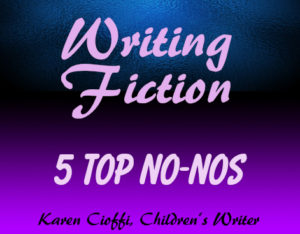 Fiction writers who are good at what they do, enjoy what they do. They like creating something from nothing . . . well from an idea. They enjoy the craft and the process.
Fiction writers who are good at what they do, enjoy what they do. They like creating something from nothing . . . well from an idea. They enjoy the craft and the process.
But, with that said, there are 4 top mistakes these writers make.
1. You make the beginning of your story all roses.
While we’d all love to live in a peaceful, happy land, readers need something to sink their teeth into, especially at the beginning of the story.
The beginning of your story is the hook. It’s where you GRAB the reader and make her have to turn the page and want to know what’s going to happen to the protagonist.
Here are a couple of examples of ‘hooking’ beginnings:
“I have noticed that teachers get exciting confused with boring a lot. But when my teacher said, ‘Class, we have an exciting project to talk about,’ I listened away.”
“The Talented Clementine” by Sara Pennypacker.
“My name is India Opal Buloni, and last summer my daddy, the preacher, sent me to the store for a box of macaroni-and-cheese, some white rice, and two tomatoes and I came back with a dog.”
“Because of Winn-Dixie” by Kate DiCamillo
These two examples of children’s writing give you a good idea of what it takes to ‘hook’ the reader.
2. The dialog is weak, fluffy.
Having weak dialog can kill your story. You need your characters to have passion . . . to have life.
You want dialog that is strong and tight. You want the emotion (the conflict, the tension, the passion) to come through the words. And, you want to say it in as few words and as realistically as possible.
You want the reader to feel what the character is feeling at that moment.
If Bob is angry in the story, show it through his dialog:
“WHAT! Who said you could take that?!”
“Hey! What are you doing?!”
“No! You can’t. Now get lost.”
“Get your hands off of me!”
The tight, strong dialog goes for exchanges also:
“Hey! What are you doing?!” Bob yelled.
Gia spun around. “Oh, ugh, nothing.” Her eyes darted to the door then back to Bob.
3. The story is predictable.
You’ve got to have some surprises in the story. If you don’t, it will make for a rather dull, predictable story.
For this aspect of your story, think questions.
– Why is the character in that situation?
– How did he get there?
– What must she be feeling, seeing?
– How can see get out of it?
– What might happen next?
Try to come up with four or five options as to what might happen next.
In an article at Writer’s Digest, the author advises to “Close your eyes and watch your scene unfold. Let the characters improvise. What are some outlandish things that could result? If something looks interesting, find a way to justify it.” (1)
Let your imagination run wild.
4. Your characters are one-dimensional.
For readers to become engaged in a story, they have to develop a connection with the protagonist and other characters. In order for this to happen, the characters must be multi-dimensional.
Characters need to be believable and unique. You don’t want them to be predictable or a stereotype.
According to “Breathing Life into Your Characters” by Rachel Ballon, Ph.D., “The essential components for creating successful characters with emotional and psychological depth—feelings, passion, desires, psychology, and vision—reside within [the writer].”
So, think about it. What conditions or characteristics does your character have?
– Does he have a personality disorder?
– Does he have phobias?
– Is she dysfunctional?
– Is she a troublemaker or bully?
– Is he anxious?
– Does she have an eating disorder?
– Is she fearful?
– Is she a risk taker, fearless?
And, keep in mind that the more stressful an ‘inciting incident’ or event, the more reaction and/or adjustment there will be.
For example: If a child lost a pet, it wouldn’t be as severe as losing a parent.
If a woman became separated from her husband, it wouldn’t be as severe as having her husband suddenly die.
So, using your experiences and innate characteristics, along with research, you can create multi-faceted characters.
5. You dump information into the story.
This is more of a mistake that new writers may make. I had a client who created the entire first paragraph of her middle-grade story with ‘information dump.’
She had the protagonist talking to a stuffed animal, in a pretend interview. She gave backstory and other details she wanted to convey to the reader through the interview. She didn’t realize that this information needed to be layered or weaved into the story, not dumped in one big truck load.
You might also use a prologue to give backstory.
While there are other things to watch for in fiction writing, these are five of the top no-nos.
Reference:
(1) 5 Biggest Fiction Writing Mistakes and Fixes
MORE ON WRITING FOR CHILDREN
Writing – 6 Essential Steps to Publication
Why Hiring a Ghostwriter for Your Children’s Book is a Good Idea
Submitting Queries – Be Specific and Professional



